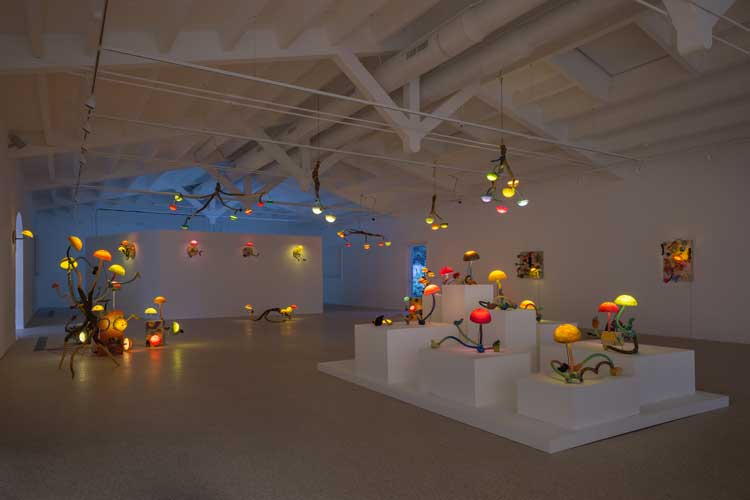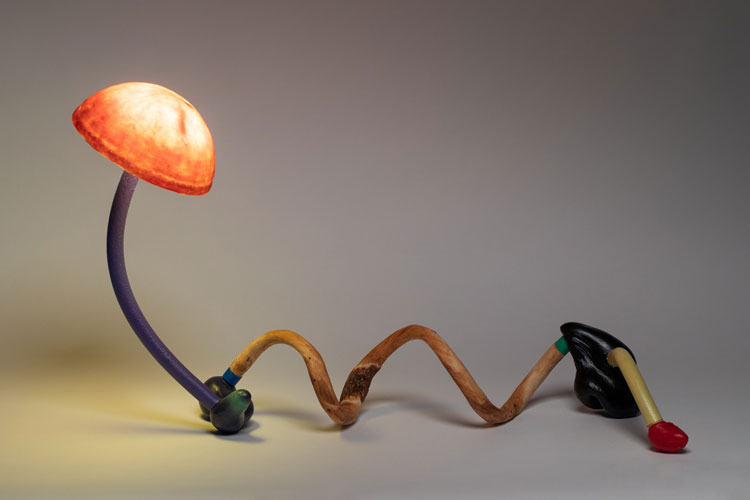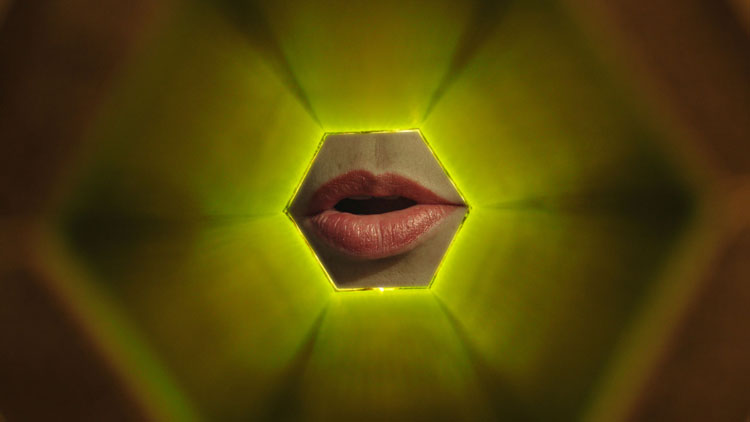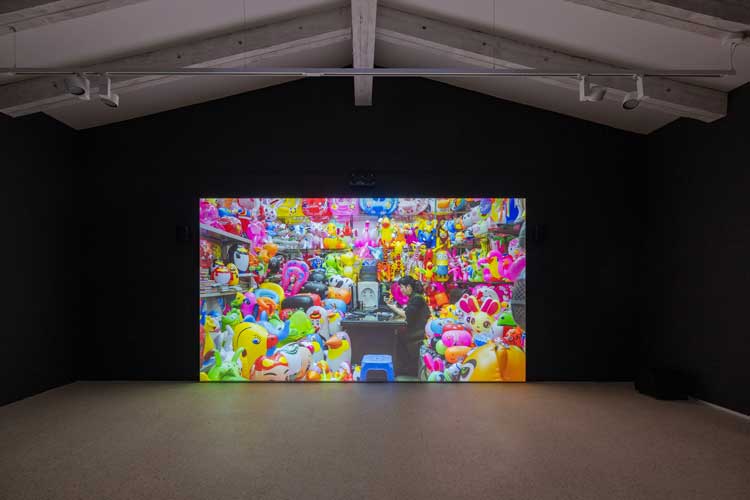.jpg)
Mika Rottenberg and Garlan Miles construct the bar, sculptures and lamps that adorn Manuela restaurant in SoHo, NYC. Photo: Oresti Tsonopoulos. © Mika Rottenberg. Courtesy the artist and Hauser & Wirth.
by ANNA McNAY
Mika Rottenberg was born in 1976 in Buenos Aires, Argentina, but grew up in Israel. She moved to New York in 2000 to complete her education and has remained there. Her hard-hitting work exploits the senses to seduce viewers into facing the contradictions of fact and fiction, the natural and the artificial, in all walks of life. Her video works and sculptures have won her numerous awards, and, in 2018, she was invited as a guest artist to Cern, the Geneva-based European laboratory for particle physics. Her current exhibition at Hauser & Wirth Menorca draws attention to the absurdity of our global situation, harnessing imagery that is simultaneously pleasurable and troubling.
Anna McNay: Can we start by talking a bit about your current exhibition at Hauser & Wirth in Menorca? What are you showing there and what is the premise of the show?
Mika Rottenberg: In Menorca, there are three main bodies of work. You enter to the Lampshares (2024-25), which are more recent. These light sculptures are made from recycled plastic and invasive vines. Then, at the back, there is Spaghetti Blockchain (2019), which is a three-screen installation. It started as a one-screen installation but evolved into a three-screen installation shot in different places, from in the studio to out in the world. And then there is also Cosmic Generator (2017), which is another video installation.

Mika Rottenberg, Vibrant Matter, installation view, Hauser & Wirth Menorca, 2025. Photo: Damian Griffiths. © Mika Rottenberg, courtesy the artist and Hauser & Wirth.
AMc: You work across a number of mediums. How would you describe your work in general? Is it primarily aesthetically, materially or thematically driven?
MR: There’s always a concept, of course. That’s what drives me. But the concept is visual and emotional. It’s not a verbal concept.
AMc: How important is it for you to create an immersive setting for your viewer?
MR: It’s not so important that it’s immersive. I believe that you immerse yourself into stuff in your own brain. I don’t want to encourage a spoilt viewer who expects to be immersed and just passively stand or lie there. But I often play with manipulation and seduction of the viewer through aesthetics to create a place that they’re immersed in. But it’s not all as sweet and sparkly as it might seem.
.jpg)
Mika Rottenberg, Spaghetti Blockchain (Video Still), 2019. 4k video installation with 7.1 surround sound, colour; 18:15 min. Dimensions variable. © Mika Rottenberg, courtesy the artist and Hauser & Wirth.
AMc: When you do create an immersive setting, though, does each individual component piece stand alone as a work in its own right?
MR: Of course. When I put them together, it’s usually architectural, and I work with the flow of the space to create an overall experience of walking through the space.
AMc: How would you describe the materials you work with?
MR: I have always been interested in materiality and materialism, matter and materials. That has always been a thing. And recently I have been interested in really diving into the materials that I use in the studio and forming a different relationship with the supply chain of the materials. All the materials I work with, most of them anyhow, are sourced locally. Often, it’s discarded plastic that I collect, or I work with a great organisation called Inner City Green Team, and they collect the plastic from the streets of New York City, because there’s no real recycling; recycling is a scam basically. Plastic is a great material. I mean, it’s a toxic material, but it’s very hard to live in the world currently without it, unless you go extremely off grid, which I’m considering, but not yet. It’s a super-pliable material. So, it’s quite a journey to collect it, and then I design different machines to work with it, very DIY machines, together with Gary Dusek, a designer. We build these DIY machines inspired by Precious Plastic, which is an online community, open source, for how to make DIY plastic things. So, that has been a new direction that is about making things. Then, in the videos, there is a lot of exploration of materials and matter and where things come from and all the human labour, emotional labour, exploitation and beauty, or seduction, that’s put into them, and our relationship with materials and objects.
.jpg)
Mika Rottenberg, Cosmic Generator (Loaded #2) (Video Still), 2017/2018. Single channel video installation, sound, colour; 26:36 min. Dimensions variable. © Mika Rottenberg, courtesy the artist and Hauser & Wirth.
AMc: Do you align yourself with any particular world view? For example, your work speaks about capitalism and the production of value.
MR: Yes, I’m interested in queer ecology as a frame of thinking and object-based anthropology as a more conceptual frame. For me, the concept always arrives after the idea is there. So, the ideas come, and then I find a more verbal, conceptual thinking that complements them. It’s not like I first need the support of a book or a thinker from a verbal perspective, or academic perspective, to justify making the work. As an artist, I come from visual thinking, experiential thinking, and am hopefully authentic to my own experience of the world. That is what is great about art: you can be stupid and just play with materials and your own feelings, thoughts and experiences and not use a theory as a crutch or a justification. But definitely queer ecology, which, from what I understand, is about not thinking in binary terms. What is natural and what is artificial? I guess that’s the question. Then dissolving that binary. My views are not purist. Obviously, plastic is a toxic material, and producers of it should be fined heavily and clean up their mess, but that isn’t my artist’s opinion. My artist’s opinion is: “Wow, it’s shiny. It’s so cool. It could do all these things. And it’s toxic.” It looks bodily, but it’s synthetic. But it’s also made from fossil fuels, which are very much natural, whatever that means. I guess there is a pre-judgment, but when I come and look at a material as an artist, there’s more scope for understanding and not a necessarily a moral judgment. I’m interested in exploring the full spectrum of my behaviours and feelings and actions as a person. I’m not an angel or a political activist. I want to be authentic. I love plastic – and I hate it.
AMc: Can you explain a bit about ASMR (autonomous sensory meridian response) and how this plays a part in your work?
MR: I am really fascinated by the sounds that materials make when they really resonate viscerally. I have been into that since the late 90s, playing with dough and different crackling sounds and Jell-O and those maraschino cherries that all have different kinds of visceral sounds. That was before the term ASMR was even coined, and before everyone had access to cameras and made these videos – there are so many people now, and they’re doing it so well, including 15-year-olds – it has been a humbling thing to see. But it was also a recognition that there’s something to it. Of course, there are many different creators of different quality. Some of them are stupid. I don’t like giant slime baths and that kind of thing. But some are really great.
.jpg)
Mika Rottenberg, Cosmic Generator (Loaded #2) (Video Still), 2017/2018. Single channel video installation, sound, colour; 26:36 min. Dimensions variable. © Mika Rottenberg, courtesy the artist and Hauser & Wirth.
AMc: The video installation Cosmic Generator (2017) has been described as the best introduction to your work. Can you tell me a bit about this piece and how it sits within, and relates to, your wider practice?
MR: It’s been almost 10 years now since I made it, which is crazy. But, yes, I think that blend between an internal space, a psychological space, the space of someone that consumes and produces things, and then connecting it to different systems that are out there, such as the small commodity market in China or the border fence in Calexico, Mexicali, that blending of fact and fiction, blending my perception of these places as a subject and the realities of these places, that’s key to my work. My experience is as a consumer. And my experience of the border … I entered the US as an immigrant, but I was legally documented. I have a relationship with borders and who is in and who is out. There’s something there, but it’s not my direct experience. So, it’s always a blend. Although, after 2016 and the first Trump terms, politicians and the people around him started blending fact and fiction. My work since then doesn’t do it any more because he does it so well. It used to be the case that politicians and the press should at least try to stick to the facts, and artists were the ones to have the liberty to bend facts and make them into fiction. When it became such a mainstream and shameless thing for politicians to do, it was very confusing to me as an artist.
AMc: What was it that took you to New York in the first place?
MR: I just thought that it was a great place for an artist to be, with all the artists that live here and all the exhibitions and so on. And I spoke English. New York was the place to go in the late 90s.
AMc: You had already studied art in Israel.
MR: Yes. But I came to complete my bachelor’s degree and then I did my master’s. The great thing about it is that then you meet a lot of other artists, and, in New York, you often meet your idols. I never thought I could study with someone like Haim Steinbach or Marilyn Minter or Kara Walker – all these people that I had been looking at in magazines and books and suddenly they were alive and talking to me about my work. That was like: “Whoa!” I couldn’t believe it could happen.

Mika Rottenberg, Lampshare, 2024. Milled reclaimed household plastic and bittersweet vines. Lighting component: batteries, resin, and electric hardware, 45.7 x 76.2 x 27.9 cm (18 x 30 x 11 in). Photo: Pete Mauney. © Mika Rottenberg, courtesy the artist and Hauser & Wirth.
AMc: Who else do you look to for inspiration?
MR: It’s really the world. It’s not so much through art. You know, I’m not an artists’ artist. My work is about certain things that I feel and that happen in the world and how I process them. It’s a way to process them. I’m not saying: “Oh, this is how it should be, or this is how you should process this.” It’s my reaction to the world. That’s what I think art is. So, I don’t need to look at anyone else’s processing of reality to be inspired. Of course, a lot of artists do inspire me, and some works inspire me. But I think I’m more in dialogue with the unprocessed world, processed through a more popular culture.
AMc: You have also made a feature-length film, Remote (2022). Do you consider this a part of your art practice, or something else alongside?
MK: It’s definitely still an art film, although we tried to make it watchable and to have a plot and to be something that young people can watch and not necessarily just an art audience. I always wanted to experiment with storyline and plot as part of the work. So that was a way to do that. And I always wanted to make a feature, so I did.
AMc: Can you say a bit about the process of making a work? Where is your starting point and how do you proceed in your studio?
MR: It’s really small steps. I start with sketching different ideas and things that resonate. And a feeling that resonates. And the material and the sound. Then I start to develop it, and it grows and grows and grows. It’s a dialogue between me and the work. You could think about things for ever and write stuff down, but once you start working in a material and space, then they have their own say in what to do. It’s a dialogue between my thoughts and then putting something out there.

Mika Rottenberg, Spaghetti Blockchain (Video Still), 2019. 4k video installation with 7.1 surround sound, colour; 18:15 min. Dimensions variable. © Mika Rottenberg, courtesy the artist and Hauser & Wirth.
AMc: Tell me about your use of colour. At what point does that come in?
MR: Colour is so psychological, emotional and seductive. I think it comes second, maybe. First, it’s trying to understand what the work is about from the beginning, what kind of feeling it’s going to try to explore. And then all these things develop around that. And then colour comes in. But it’s definitely really important.
AMc: Do you have a lexicon of motifs and symbols that you draw on?
MR: Yes, for sure. I’m more and more comfortable now saying: “Yes, this is part of my language, and I could use it.” I used to think: “Oh, I’m using this again. I should use something else.” But I feel like the way my work has evolved is that there are now these existing motifs and then there are other things that are added that are very specific to each work. Each work has something new, and it also has the existing language that makes sense of it all.
AMc: To come back to your Hauser & Wirth exhibition, what do you want visitors to take away from it, or how do you hope they will respond?
MR: I don’t know. I hope that they care enough to look at it. There is so much visual stimulation. I hope people will think about the way things are made in a more critical way, rather than being disgusted by it all. I’d like them to jump in and not get discouraged, and to use creativity to find ways to turn problems into solutions. That sounds like a slogan, but I feel capitalism is so much about finding solutions to things that are not a problem, so maybe it should be more invested in finding solutions to things that are a problem.
• Mika Rottenberg: Vibrant Matter is at Hauser & Wirth Menorca until 26 October 2025.

Mika Rottenberg, Vibrant Matter, installation view, Hauser & Wirth Menorca, 2025. Photo: Damian Griffiths. © Mika Rottenberg, courtesy the artist and Hauser & Wirth.